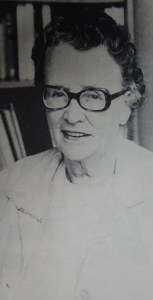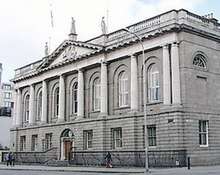Victoria Coffey
Victoria Coffey (September 16, 1911 – June 15, 1999)[1][2] graduated from the Royal College of Surgeons in Ireland and became a paediatrician, and later one of the first people to research sudden infant death syndrome (SIDS) and one of the first females to undertake significant research into congenital abnormalities.[3] She also became the first female president of the Irish Paediatric Association, the paediatric section of the Royal Academy of Medicine in Ireland, the Royal College of Surgeons of Ireland (RCSI) Post-graduate Association, and the Irish American Pediatric Association. Coffey was also the first female recipient of the RCSI Distinguished Graduate medal.[3]
Victoria Coffey Medical Research Council of Ireland, Irish Paediatric Association, American College of Physicians | |
|---|---|
 | |
| Born | September 16, 1911 |
| Died | June 15, 1999 (aged 87) |
| Nationality | Irish |
| Education | Royal College of Surgeons in Ireland |
| Known for | Sudden infant death syndrome |
Early life and family
.jpg)
Victoria Philomela Dorothy Coffey[4][5] was born on 16 September 1911 at 108 Brunswick Street (now Pearse Street) in Dublin, Ireland. She was the daughter of John Coffey, a weigh-master, cattle exporter and bookmaker[5][3] and Ellie Coffey, who ran The Royal Arms in Kilcullen.[3][5][6] Her paternal grandfather William Coffey had been Lord Mayor of Dublin from 1909 to 1910.[3][7][6] During her childhood, Victoria—known to friends as "Viki"—[3][8] won numerous medals for her musical performances. She played the piano and cello, and trained as a singer under instruction from Vincent O'Brien.[4]
Coffey had 10 siblings.[4][5] Her younger sister Pauline also became a doctor and won prestigious awards in the Royal College of Surgeons.[9][3] Five of Coffey's siblings died as children—four in infancy.[4][5][9] According to Coffey's grand-nephew Robert Coffey, "that was one of the main reasons she was so motivated to learn about the health of newborns and young children".[8] He described her as "a no nonsense person but with quite a wicked sense of humour".[8] She helped raise for the Dominican mission (now the Dublin Christian Mission), with which her brother Cecil was associated.[10] She survived poliomyelitis in 1955.[7]
Education and career
.jpg)
Coffey was known for her diligence and hard work.[11] At the age of 25, she qualified for the Royal College of Surgeons in Ireland (RCSI),[7][11][8] where she graduated with a licentiate degree and a degree in midwifery from the conjoint board of the RCSI.[12][11] Seven years later, in 1943, she earned a DPH diploma in Children's Health at the RCSI.[7][12]
She developed strong qualities of leadership, responsibility, and pugnacious personality by working with men such as Tom Lane, Henry Stokes and Oliver St. John Gogarty at Meath Hospital,[11] the cradle of the Dublin School of Medicine, where she was a student and house officer.[7] In the same year, she served as a clinical clerk at Coombe Hospital for Women.[11] Shortly afterwards, she was appointed as a medical officer in St Kevin's Hospital[8][11] due to her knowledge of obstetrics.[7] At St. Kevin's Hospital, Coffey became interested in the neglected field of congenital birth defects[11] and began a publishing career. She was motivated to learn about the health of babies and young children, and focused on paediatrics.[11][13]
Coffey's first paper, which she wrote in 1953, is about syphilis in children.[7] Her research mainly focused on children born with congenital and metabolic diseases,[1] and was completed with the help of the Medical Research Council, Trinity College Dublin and Professor Jessop of Meath Hospital.[7] She then began to research sudden infant death syndrome (SIDS), and was one of the first women to study it.[8][11] Her numerous publications covered most aspects of congenital disorders.[8] In 1954, Coffey gave a paper on this topic at the Royal Academy of Medicine in Ireland.[11]
Coffey published her findings in the Irish Journal of Medical Science between 1955 and 1959.[11] In recognition of her work in paediatrics, she was appointed lecturer in teratology at Trinity College Dublin in 1961,[4][8] earning a Ph.D. from the University of Dublin in 1965 for a thesis on the incidence and aetiology of congenital defects in Ireland.[11][8] She published internationally and maintained her research output for several years after her retirement.[11] Coffey founded the Faculty of Paediatrics at the RCPI in 1981 and was the first female president of the Irish Paediatric Society.[13]
Later life and legacy

Coffey lived in Rathmines, a suburb of Dublin, with her parents before their deaths, and remained there until her own death.[4] She died at 87 on 25 June 1999 in St. James's Hospital, where she had worked most of her life.[3] She is buried in Glasnevin Cemetery, Dublin;[4] according to Lynn Brady, Coffey's grave is at the LF103 Garden Section of the cemetery.[14]
On International Women's Day in 2018, Coffey was honoured for her outstanding contribution to medicine and was chosen to be part of "Women on Walls", an arts project hosted by RCSI in partnership with Accenture, with her portrait displayed in the RCSI's principal boardroom.[8][15]
References
- "Dr. Victoria Coffey | Accenture". www.accenture.com. Retrieved 11 November 2018.
- "Women on Walls at RCSI in partnership with Accenture" (PDF). Business to Arts. Retrieved 29 March 2019.
- Hayes, Cathy (2018). "Dr. Victoria Coffey (1911 – 1999) -". RCSI women. Archived from the original on 4 January 2019.
- https://www.geni.com/people/Victoria-Coffey-Dr/6000000020662222581 Retrieved=2018-10-27
- "John Coffey". geni_family_tree. Retrieved 11 November 2018.
- "Where was Ellie Coffey's bar?". Kilcullen Diary. 5 September 2015.
- "Dr Victoria Coffey". The Irish Times. 9 August 1999.
- Pollak, Sorcha (3 March 2018). "The female trailblazers of Irish medicine". The Irish Times. Retrieved 11 November 2018.
- "Pauline Kathleen Hazel Mansell". geni_family_tree. Retrieved 17 November 2018.
- "Cecil Angelus Augustine Coffey, O.P." geni_family_tree. Retrieved 17 November 2018.
- "Dr. Victoria Coffey (1911 – 1999) - RCSI women". RCSI women. 4 March 2018. Retrieved 22 November 2018.
- "Brunswick Street Archives - RCSI women". RCSI women. Retrieved 22 November 2018.
- Hayes, Cathy (2018). Coffey, Victoria. Dublin, Ireland: Dictionary of Irish Biography. Retrieved 8 March 2018.
- www.wandsoft.com, Content Management: WANDSOFT. "Genealogy Glasnevin Cemetery & Museum | Dublin Tourist Attractions | Glasnevin Trust". www.glasnevinmuseum.ie. Retrieved 17 November 2018.
- "Six artists commissioned to create a series of new portraits of historical female leaders in healthcare". Dublin Times. Retrieved 17 November 2018.